Urbanization and Air Pollution: Causes, Effects, and Solutions
VerifiedAdded on 2023/01/17
|9
|1692
|33
AI Summary
This paper explores the causes, effects, and solutions of air pollution caused by urbanization. It provides insights into the impact of urbanization on the environment and offers relevant solutions to reduce pollution levels.
Contribute Materials
Your contribution can guide someone’s learning journey. Share your
documents today.
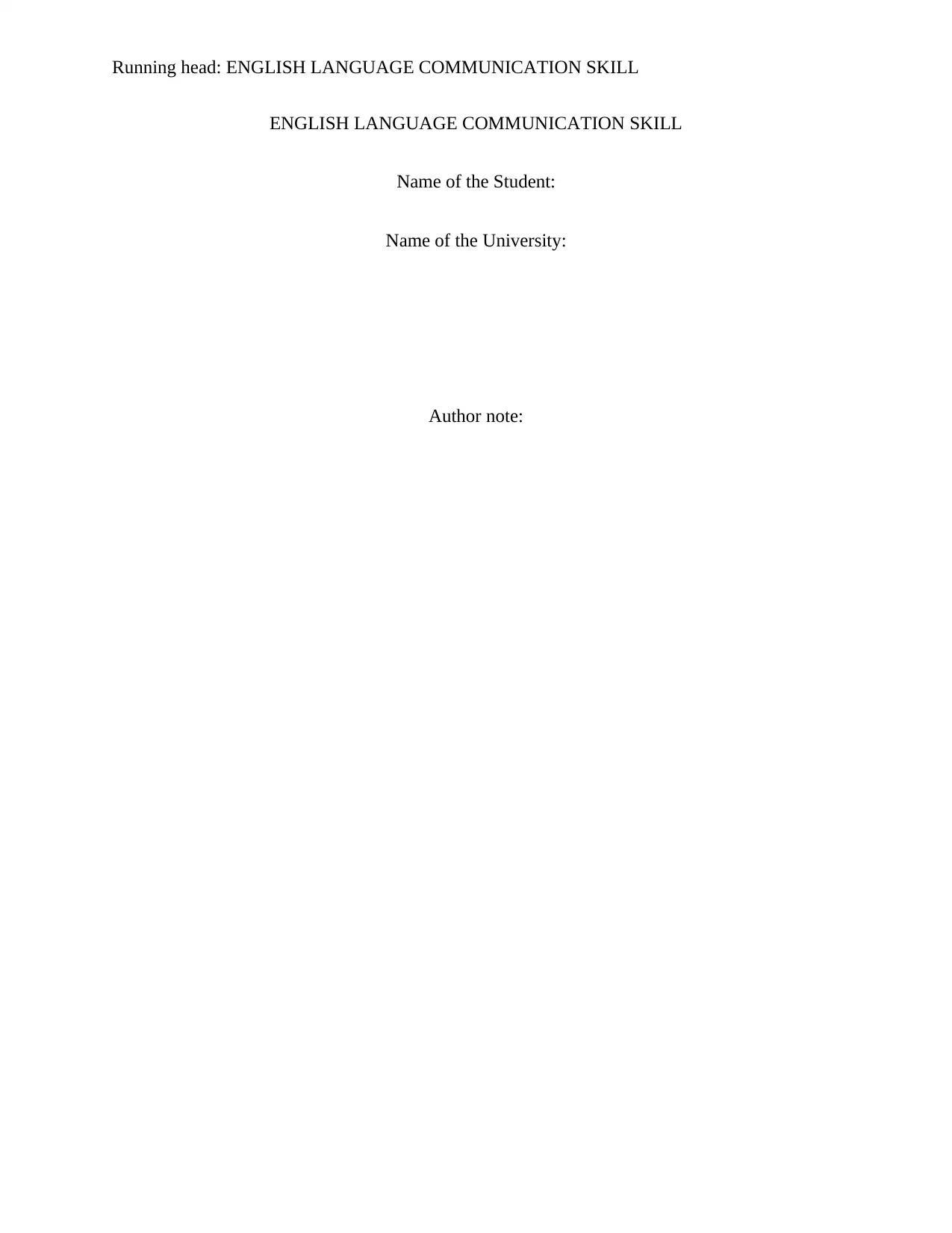
Running head: ENGLISH LANGUAGE COMMUNICATION SKILL
ENGLISH LANGUAGE COMMUNICATION SKILL
Name of the Student:
Name of the University:
Author note:
ENGLISH LANGUAGE COMMUNICATION SKILL
Name of the Student:
Name of the University:
Author note:
Secure Best Marks with AI Grader
Need help grading? Try our AI Grader for instant feedback on your assignments.
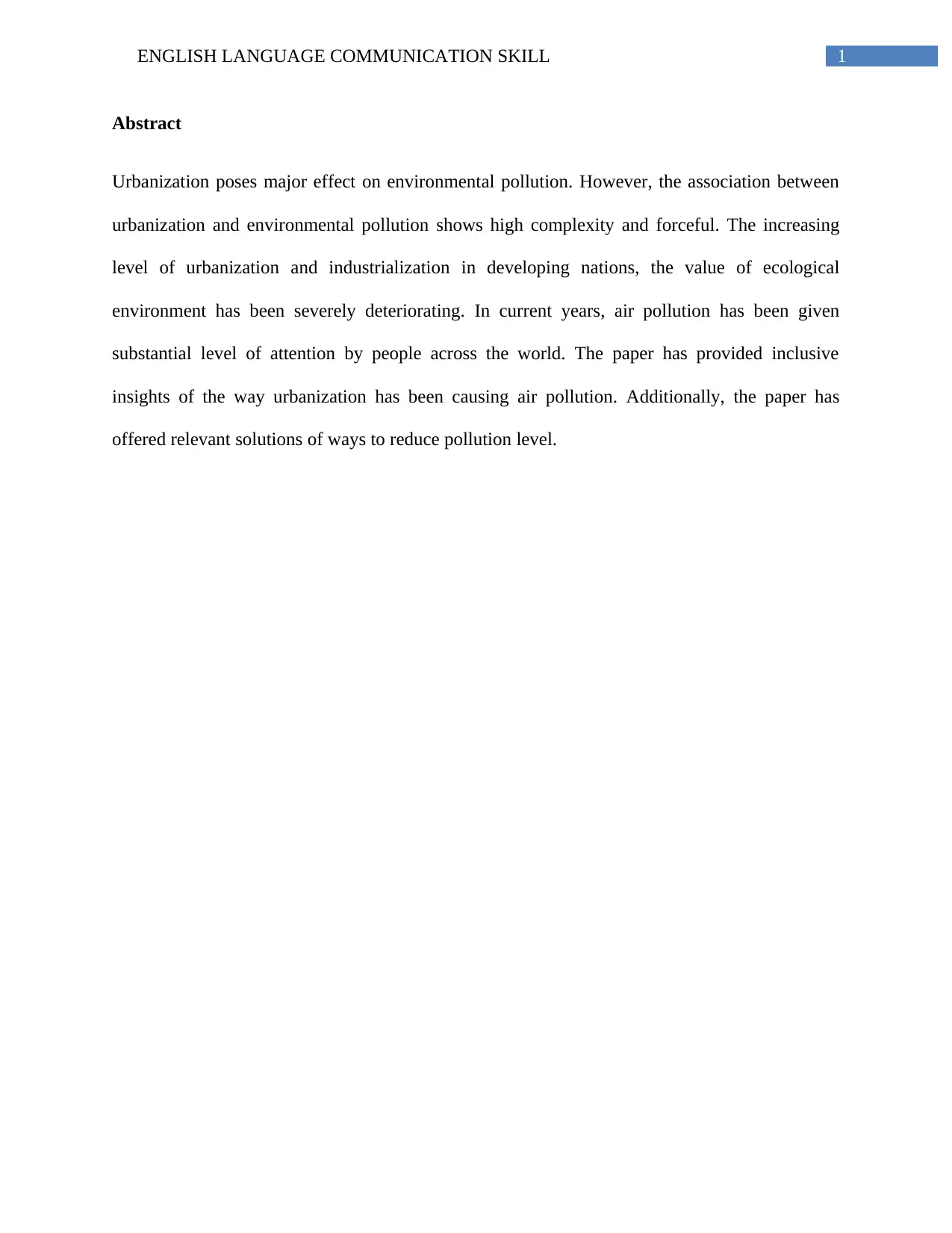
1ENGLISH LANGUAGE COMMUNICATION SKILL
Abstract
Urbanization poses major effect on environmental pollution. However, the association between
urbanization and environmental pollution shows high complexity and forceful. The increasing
level of urbanization and industrialization in developing nations, the value of ecological
environment has been severely deteriorating. In current years, air pollution has been given
substantial level of attention by people across the world. The paper has provided inclusive
insights of the way urbanization has been causing air pollution. Additionally, the paper has
offered relevant solutions of ways to reduce pollution level.
Abstract
Urbanization poses major effect on environmental pollution. However, the association between
urbanization and environmental pollution shows high complexity and forceful. The increasing
level of urbanization and industrialization in developing nations, the value of ecological
environment has been severely deteriorating. In current years, air pollution has been given
substantial level of attention by people across the world. The paper has provided inclusive
insights of the way urbanization has been causing air pollution. Additionally, the paper has
offered relevant solutions of ways to reduce pollution level.
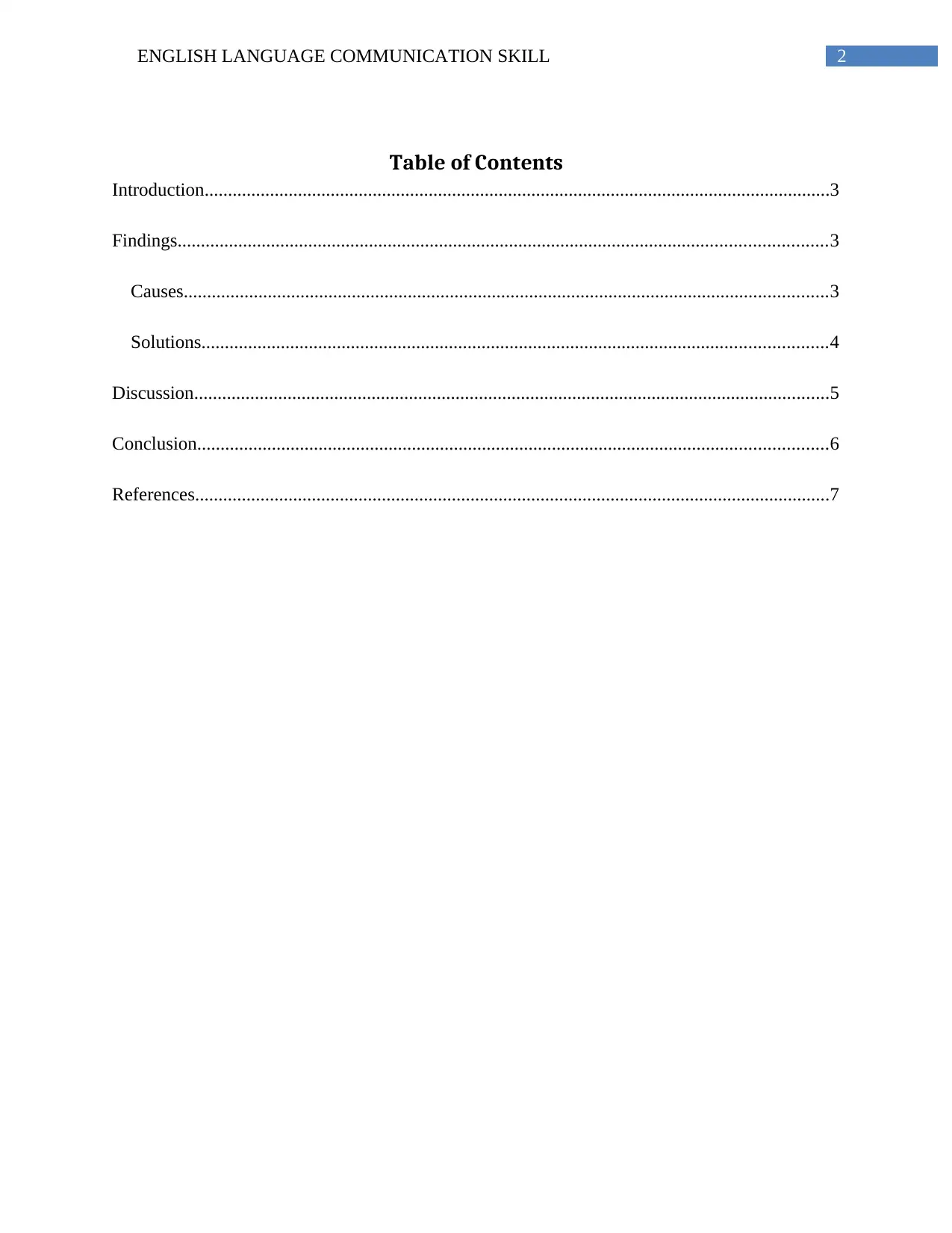
2ENGLISH LANGUAGE COMMUNICATION SKILL
Table of Contents
Introduction......................................................................................................................................3
Findings...........................................................................................................................................3
Causes..........................................................................................................................................3
Solutions......................................................................................................................................4
Discussion........................................................................................................................................5
Conclusion.......................................................................................................................................6
References........................................................................................................................................7
Table of Contents
Introduction......................................................................................................................................3
Findings...........................................................................................................................................3
Causes..........................................................................................................................................3
Solutions......................................................................................................................................4
Discussion........................................................................................................................................5
Conclusion.......................................................................................................................................6
References........................................................................................................................................7
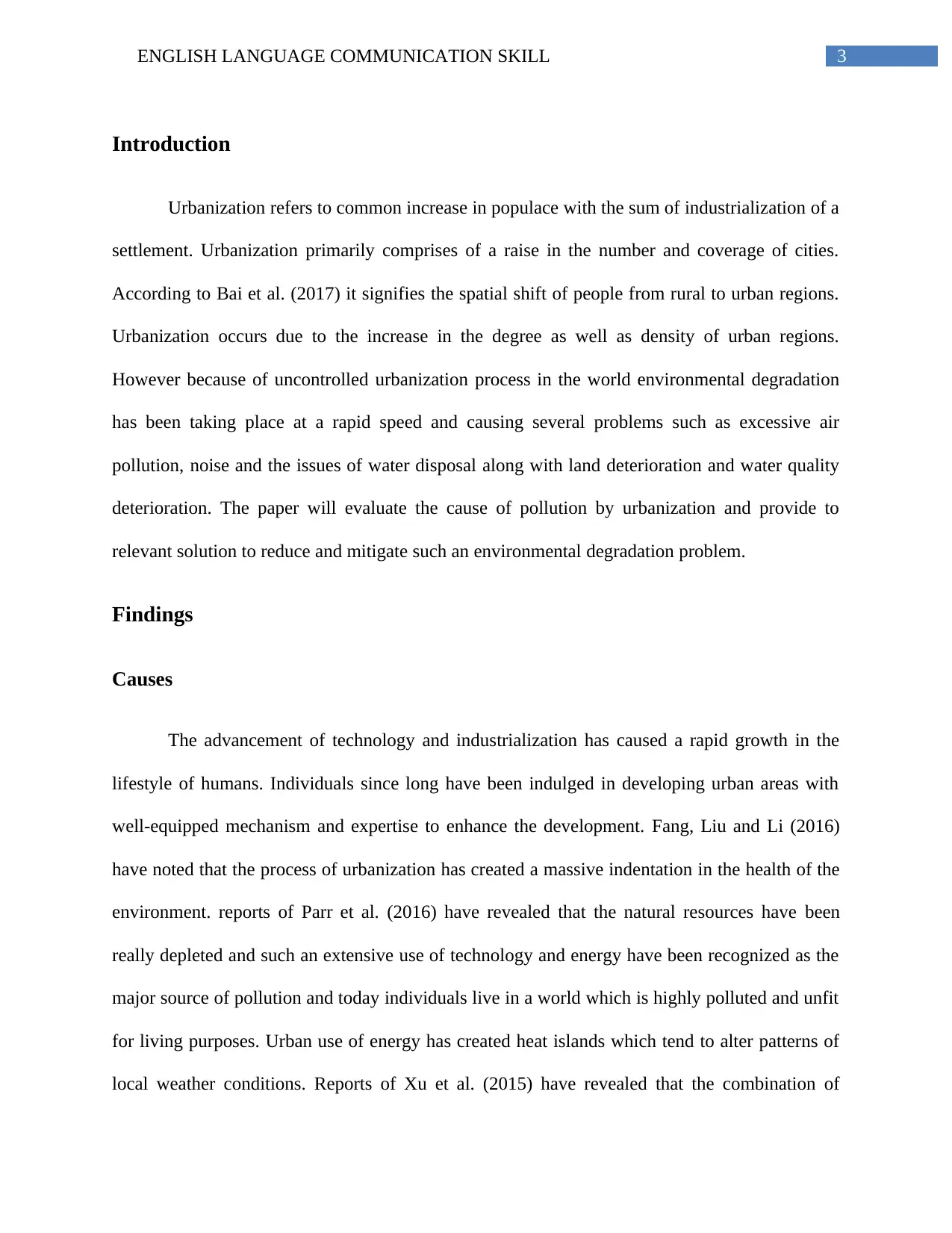
3ENGLISH LANGUAGE COMMUNICATION SKILL
Introduction
Urbanization refers to common increase in populace with the sum of industrialization of a
settlement. Urbanization primarily comprises of a raise in the number and coverage of cities.
According to Bai et al. (2017) it signifies the spatial shift of people from rural to urban regions.
Urbanization occurs due to the increase in the degree as well as density of urban regions.
However because of uncontrolled urbanization process in the world environmental degradation
has been taking place at a rapid speed and causing several problems such as excessive air
pollution, noise and the issues of water disposal along with land deterioration and water quality
deterioration. The paper will evaluate the cause of pollution by urbanization and provide to
relevant solution to reduce and mitigate such an environmental degradation problem.
Findings
Causes
The advancement of technology and industrialization has caused a rapid growth in the
lifestyle of humans. Individuals since long have been indulged in developing urban areas with
well-equipped mechanism and expertise to enhance the development. Fang, Liu and Li (2016)
have noted that the process of urbanization has created a massive indentation in the health of the
environment. reports of Parr et al. (2016) have revealed that the natural resources have been
really depleted and such an extensive use of technology and energy have been recognized as the
major source of pollution and today individuals live in a world which is highly polluted and unfit
for living purposes. Urban use of energy has created heat islands which tend to alter patterns of
local weather conditions. Reports of Xu et al. (2015) have revealed that the combination of
Introduction
Urbanization refers to common increase in populace with the sum of industrialization of a
settlement. Urbanization primarily comprises of a raise in the number and coverage of cities.
According to Bai et al. (2017) it signifies the spatial shift of people from rural to urban regions.
Urbanization occurs due to the increase in the degree as well as density of urban regions.
However because of uncontrolled urbanization process in the world environmental degradation
has been taking place at a rapid speed and causing several problems such as excessive air
pollution, noise and the issues of water disposal along with land deterioration and water quality
deterioration. The paper will evaluate the cause of pollution by urbanization and provide to
relevant solution to reduce and mitigate such an environmental degradation problem.
Findings
Causes
The advancement of technology and industrialization has caused a rapid growth in the
lifestyle of humans. Individuals since long have been indulged in developing urban areas with
well-equipped mechanism and expertise to enhance the development. Fang, Liu and Li (2016)
have noted that the process of urbanization has created a massive indentation in the health of the
environment. reports of Parr et al. (2016) have revealed that the natural resources have been
really depleted and such an extensive use of technology and energy have been recognized as the
major source of pollution and today individuals live in a world which is highly polluted and unfit
for living purposes. Urban use of energy has created heat islands which tend to alter patterns of
local weather conditions. Reports of Xu et al. (2015) have revealed that the combination of
Secure Best Marks with AI Grader
Need help grading? Try our AI Grader for instant feedback on your assignments.
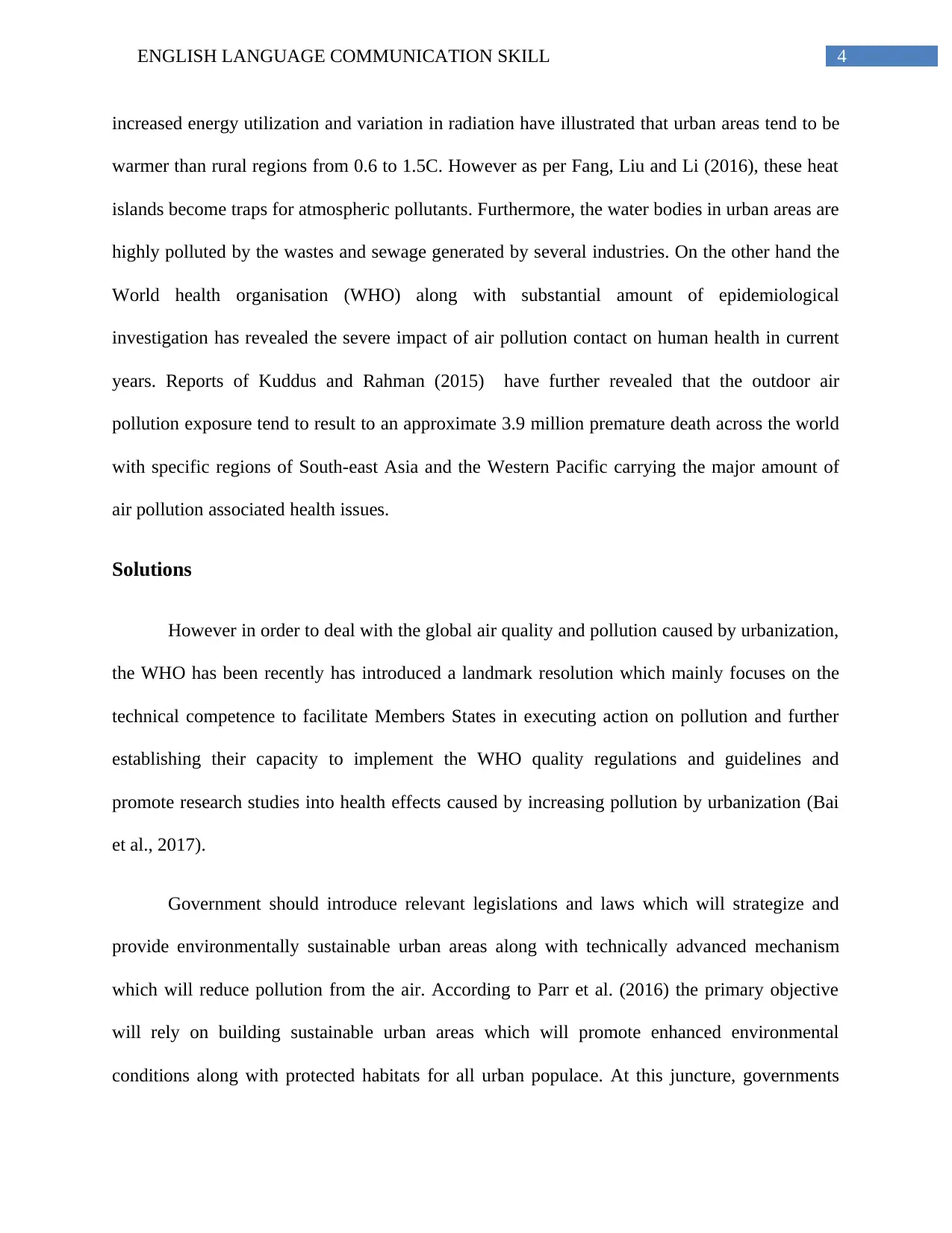
4ENGLISH LANGUAGE COMMUNICATION SKILL
increased energy utilization and variation in radiation have illustrated that urban areas tend to be
warmer than rural regions from 0.6 to 1.5C. However as per Fang, Liu and Li (2016), these heat
islands become traps for atmospheric pollutants. Furthermore, the water bodies in urban areas are
highly polluted by the wastes and sewage generated by several industries. On the other hand the
World health organisation (WHO) along with substantial amount of epidemiological
investigation has revealed the severe impact of air pollution contact on human health in current
years. Reports of Kuddus and Rahman (2015) have further revealed that the outdoor air
pollution exposure tend to result to an approximate 3.9 million premature death across the world
with specific regions of South-east Asia and the Western Pacific carrying the major amount of
air pollution associated health issues.
Solutions
However in order to deal with the global air quality and pollution caused by urbanization,
the WHO has been recently has introduced a landmark resolution which mainly focuses on the
technical competence to facilitate Members States in executing action on pollution and further
establishing their capacity to implement the WHO quality regulations and guidelines and
promote research studies into health effects caused by increasing pollution by urbanization (Bai
et al., 2017).
Government should introduce relevant legislations and laws which will strategize and
provide environmentally sustainable urban areas along with technically advanced mechanism
which will reduce pollution from the air. According to Parr et al. (2016) the primary objective
will rely on building sustainable urban areas which will promote enhanced environmental
conditions along with protected habitats for all urban populace. At this juncture, governments
increased energy utilization and variation in radiation have illustrated that urban areas tend to be
warmer than rural regions from 0.6 to 1.5C. However as per Fang, Liu and Li (2016), these heat
islands become traps for atmospheric pollutants. Furthermore, the water bodies in urban areas are
highly polluted by the wastes and sewage generated by several industries. On the other hand the
World health organisation (WHO) along with substantial amount of epidemiological
investigation has revealed the severe impact of air pollution contact on human health in current
years. Reports of Kuddus and Rahman (2015) have further revealed that the outdoor air
pollution exposure tend to result to an approximate 3.9 million premature death across the world
with specific regions of South-east Asia and the Western Pacific carrying the major amount of
air pollution associated health issues.
Solutions
However in order to deal with the global air quality and pollution caused by urbanization,
the WHO has been recently has introduced a landmark resolution which mainly focuses on the
technical competence to facilitate Members States in executing action on pollution and further
establishing their capacity to implement the WHO quality regulations and guidelines and
promote research studies into health effects caused by increasing pollution by urbanization (Bai
et al., 2017).
Government should introduce relevant legislations and laws which will strategize and
provide environmentally sustainable urban areas along with technically advanced mechanism
which will reduce pollution from the air. According to Parr et al. (2016) the primary objective
will rely on building sustainable urban areas which will promote enhanced environmental
conditions along with protected habitats for all urban populace. At this juncture, governments
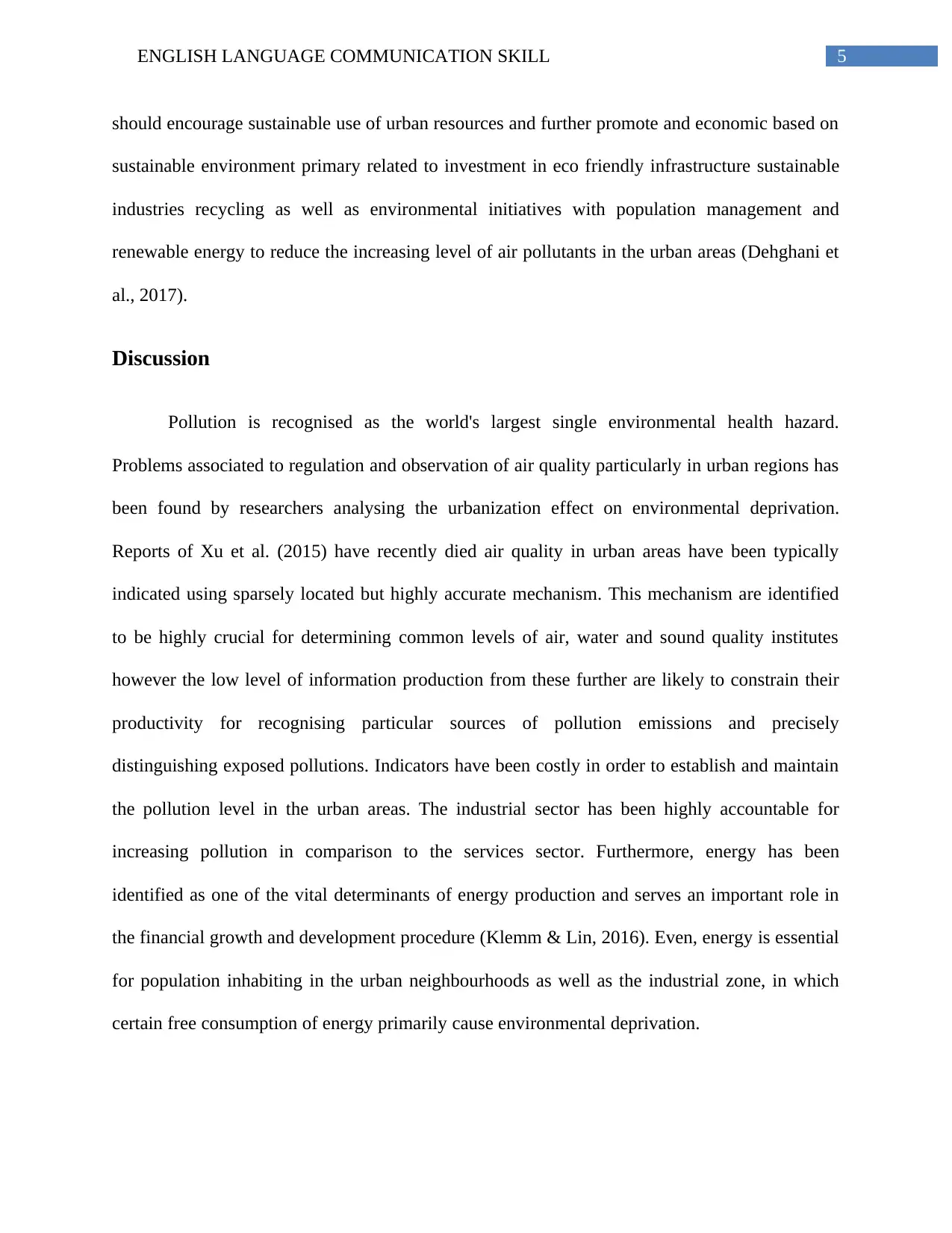
5ENGLISH LANGUAGE COMMUNICATION SKILL
should encourage sustainable use of urban resources and further promote and economic based on
sustainable environment primary related to investment in eco friendly infrastructure sustainable
industries recycling as well as environmental initiatives with population management and
renewable energy to reduce the increasing level of air pollutants in the urban areas (Dehghani et
al., 2017).
Discussion
Pollution is recognised as the world's largest single environmental health hazard.
Problems associated to regulation and observation of air quality particularly in urban regions has
been found by researchers analysing the urbanization effect on environmental deprivation.
Reports of Xu et al. (2015) have recently died air quality in urban areas have been typically
indicated using sparsely located but highly accurate mechanism. This mechanism are identified
to be highly crucial for determining common levels of air, water and sound quality institutes
however the low level of information production from these further are likely to constrain their
productivity for recognising particular sources of pollution emissions and precisely
distinguishing exposed pollutions. Indicators have been costly in order to establish and maintain
the pollution level in the urban areas. The industrial sector has been highly accountable for
increasing pollution in comparison to the services sector. Furthermore, energy has been
identified as one of the vital determinants of energy production and serves an important role in
the financial growth and development procedure (Klemm & Lin, 2016). Even, energy is essential
for population inhabiting in the urban neighbourhoods as well as the industrial zone, in which
certain free consumption of energy primarily cause environmental deprivation.
should encourage sustainable use of urban resources and further promote and economic based on
sustainable environment primary related to investment in eco friendly infrastructure sustainable
industries recycling as well as environmental initiatives with population management and
renewable energy to reduce the increasing level of air pollutants in the urban areas (Dehghani et
al., 2017).
Discussion
Pollution is recognised as the world's largest single environmental health hazard.
Problems associated to regulation and observation of air quality particularly in urban regions has
been found by researchers analysing the urbanization effect on environmental deprivation.
Reports of Xu et al. (2015) have recently died air quality in urban areas have been typically
indicated using sparsely located but highly accurate mechanism. This mechanism are identified
to be highly crucial for determining common levels of air, water and sound quality institutes
however the low level of information production from these further are likely to constrain their
productivity for recognising particular sources of pollution emissions and precisely
distinguishing exposed pollutions. Indicators have been costly in order to establish and maintain
the pollution level in the urban areas. The industrial sector has been highly accountable for
increasing pollution in comparison to the services sector. Furthermore, energy has been
identified as one of the vital determinants of energy production and serves an important role in
the financial growth and development procedure (Klemm & Lin, 2016). Even, energy is essential
for population inhabiting in the urban neighbourhoods as well as the industrial zone, in which
certain free consumption of energy primarily cause environmental deprivation.
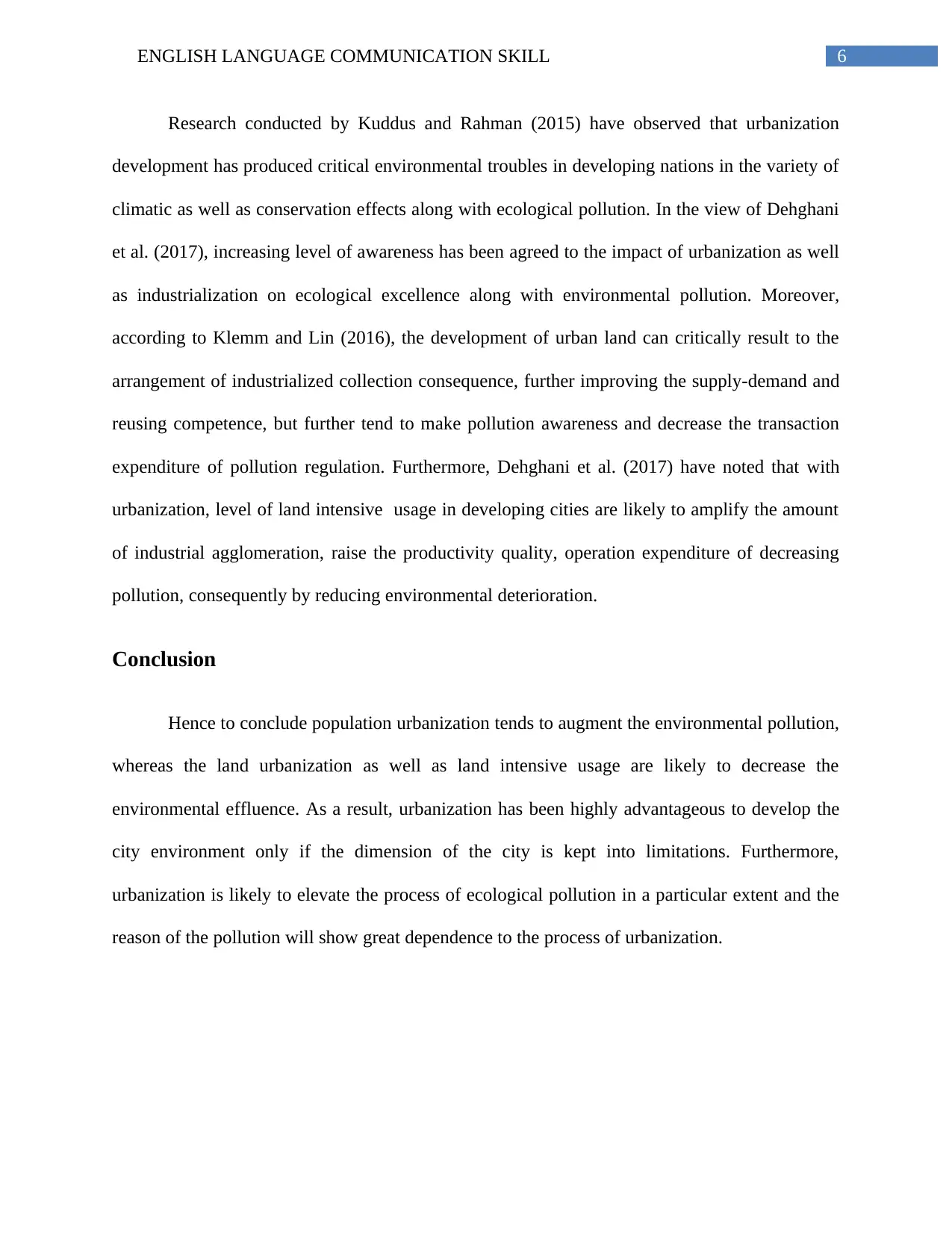
6ENGLISH LANGUAGE COMMUNICATION SKILL
Research conducted by Kuddus and Rahman (2015) have observed that urbanization
development has produced critical environmental troubles in developing nations in the variety of
climatic as well as conservation effects along with ecological pollution. In the view of Dehghani
et al. (2017), increasing level of awareness has been agreed to the impact of urbanization as well
as industrialization on ecological excellence along with environmental pollution. Moreover,
according to Klemm and Lin (2016), the development of urban land can critically result to the
arrangement of industrialized collection consequence, further improving the supply-demand and
reusing competence, but further tend to make pollution awareness and decrease the transaction
expenditure of pollution regulation. Furthermore, Dehghani et al. (2017) have noted that with
urbanization, level of land intensive usage in developing cities are likely to amplify the amount
of industrial agglomeration, raise the productivity quality, operation expenditure of decreasing
pollution, consequently by reducing environmental deterioration.
Conclusion
Hence to conclude population urbanization tends to augment the environmental pollution,
whereas the land urbanization as well as land intensive usage are likely to decrease the
environmental effluence. As a result, urbanization has been highly advantageous to develop the
city environment only if the dimension of the city is kept into limitations. Furthermore,
urbanization is likely to elevate the process of ecological pollution in a particular extent and the
reason of the pollution will show great dependence to the process of urbanization.
Research conducted by Kuddus and Rahman (2015) have observed that urbanization
development has produced critical environmental troubles in developing nations in the variety of
climatic as well as conservation effects along with ecological pollution. In the view of Dehghani
et al. (2017), increasing level of awareness has been agreed to the impact of urbanization as well
as industrialization on ecological excellence along with environmental pollution. Moreover,
according to Klemm and Lin (2016), the development of urban land can critically result to the
arrangement of industrialized collection consequence, further improving the supply-demand and
reusing competence, but further tend to make pollution awareness and decrease the transaction
expenditure of pollution regulation. Furthermore, Dehghani et al. (2017) have noted that with
urbanization, level of land intensive usage in developing cities are likely to amplify the amount
of industrial agglomeration, raise the productivity quality, operation expenditure of decreasing
pollution, consequently by reducing environmental deterioration.
Conclusion
Hence to conclude population urbanization tends to augment the environmental pollution,
whereas the land urbanization as well as land intensive usage are likely to decrease the
environmental effluence. As a result, urbanization has been highly advantageous to develop the
city environment only if the dimension of the city is kept into limitations. Furthermore,
urbanization is likely to elevate the process of ecological pollution in a particular extent and the
reason of the pollution will show great dependence to the process of urbanization.
Paraphrase This Document
Need a fresh take? Get an instant paraphrase of this document with our AI Paraphraser
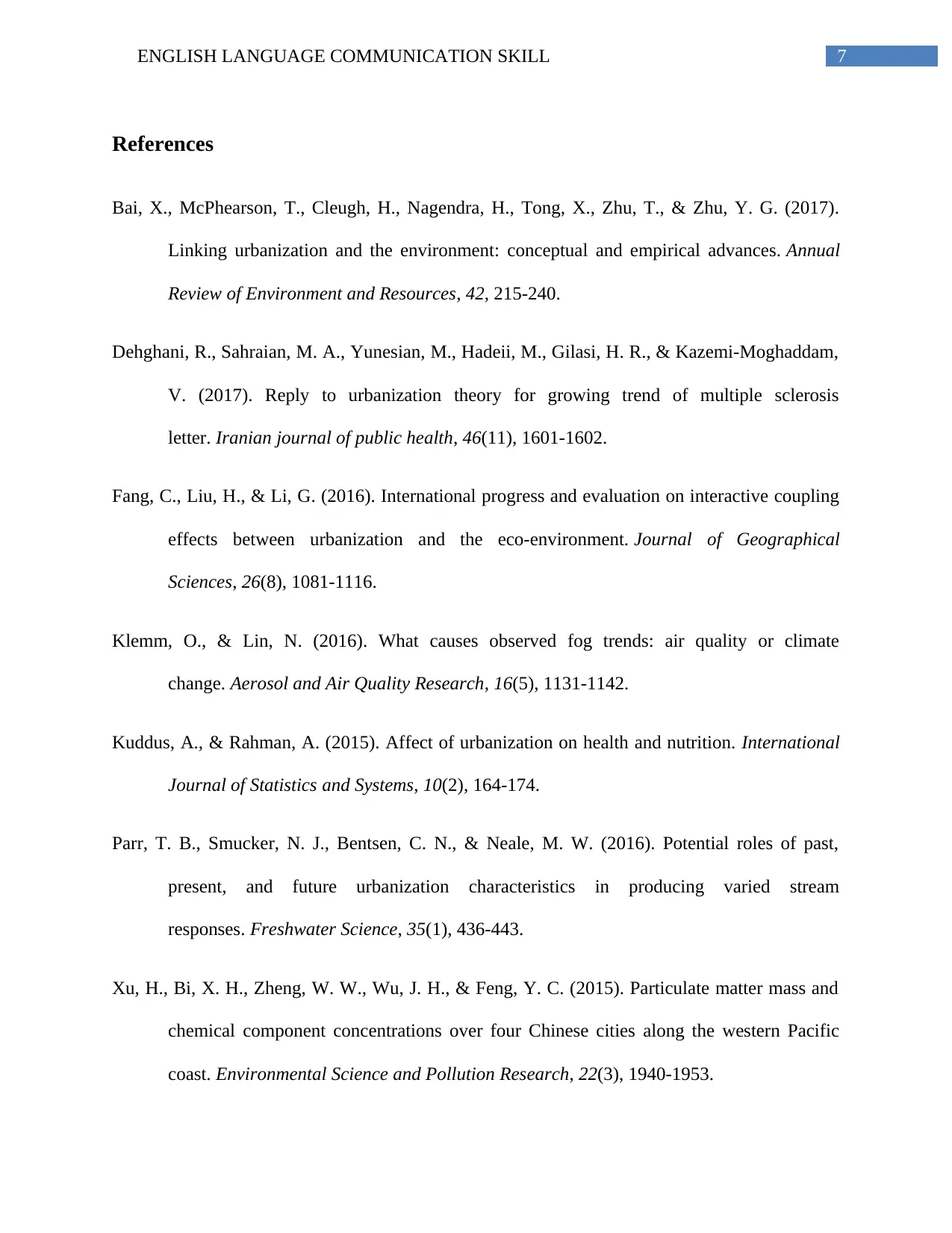
7ENGLISH LANGUAGE COMMUNICATION SKILL
References
Bai, X., McPhearson, T., Cleugh, H., Nagendra, H., Tong, X., Zhu, T., & Zhu, Y. G. (2017).
Linking urbanization and the environment: conceptual and empirical advances. Annual
Review of Environment and Resources, 42, 215-240.
Dehghani, R., Sahraian, M. A., Yunesian, M., Hadeii, M., Gilasi, H. R., & Kazemi-Moghaddam,
V. (2017). Reply to urbanization theory for growing trend of multiple sclerosis
letter. Iranian journal of public health, 46(11), 1601-1602.
Fang, C., Liu, H., & Li, G. (2016). International progress and evaluation on interactive coupling
effects between urbanization and the eco-environment. Journal of Geographical
Sciences, 26(8), 1081-1116.
Klemm, O., & Lin, N. (2016). What causes observed fog trends: air quality or climate
change. Aerosol and Air Quality Research, 16(5), 1131-1142.
Kuddus, A., & Rahman, A. (2015). Affect of urbanization on health and nutrition. International
Journal of Statistics and Systems, 10(2), 164-174.
Parr, T. B., Smucker, N. J., Bentsen, C. N., & Neale, M. W. (2016). Potential roles of past,
present, and future urbanization characteristics in producing varied stream
responses. Freshwater Science, 35(1), 436-443.
Xu, H., Bi, X. H., Zheng, W. W., Wu, J. H., & Feng, Y. C. (2015). Particulate matter mass and
chemical component concentrations over four Chinese cities along the western Pacific
coast. Environmental Science and Pollution Research, 22(3), 1940-1953.
References
Bai, X., McPhearson, T., Cleugh, H., Nagendra, H., Tong, X., Zhu, T., & Zhu, Y. G. (2017).
Linking urbanization and the environment: conceptual and empirical advances. Annual
Review of Environment and Resources, 42, 215-240.
Dehghani, R., Sahraian, M. A., Yunesian, M., Hadeii, M., Gilasi, H. R., & Kazemi-Moghaddam,
V. (2017). Reply to urbanization theory for growing trend of multiple sclerosis
letter. Iranian journal of public health, 46(11), 1601-1602.
Fang, C., Liu, H., & Li, G. (2016). International progress and evaluation on interactive coupling
effects between urbanization and the eco-environment. Journal of Geographical
Sciences, 26(8), 1081-1116.
Klemm, O., & Lin, N. (2016). What causes observed fog trends: air quality or climate
change. Aerosol and Air Quality Research, 16(5), 1131-1142.
Kuddus, A., & Rahman, A. (2015). Affect of urbanization on health and nutrition. International
Journal of Statistics and Systems, 10(2), 164-174.
Parr, T. B., Smucker, N. J., Bentsen, C. N., & Neale, M. W. (2016). Potential roles of past,
present, and future urbanization characteristics in producing varied stream
responses. Freshwater Science, 35(1), 436-443.
Xu, H., Bi, X. H., Zheng, W. W., Wu, J. H., & Feng, Y. C. (2015). Particulate matter mass and
chemical component concentrations over four Chinese cities along the western Pacific
coast. Environmental Science and Pollution Research, 22(3), 1940-1953.
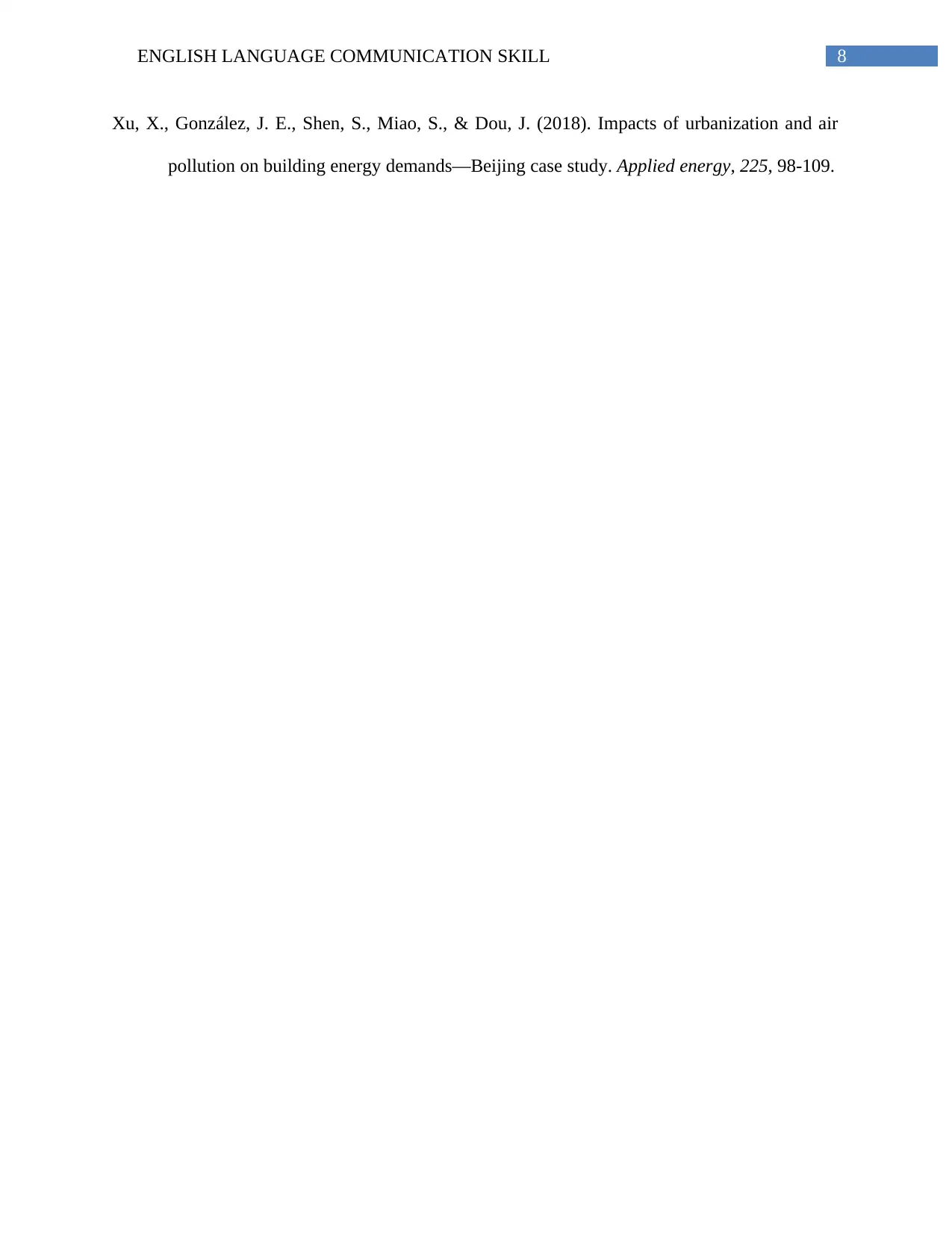
8ENGLISH LANGUAGE COMMUNICATION SKILL
Xu, X., González, J. E., Shen, S., Miao, S., & Dou, J. (2018). Impacts of urbanization and air
pollution on building energy demands—Beijing case study. Applied energy, 225, 98-109.
Xu, X., González, J. E., Shen, S., Miao, S., & Dou, J. (2018). Impacts of urbanization and air
pollution on building energy demands—Beijing case study. Applied energy, 225, 98-109.
1 out of 9
Related Documents
Your All-in-One AI-Powered Toolkit for Academic Success.
+13062052269
info@desklib.com
Available 24*7 on WhatsApp / Email
![[object Object]](/_next/static/media/star-bottom.7253800d.svg)
Unlock your academic potential
© 2024 | Zucol Services PVT LTD | All rights reserved.





